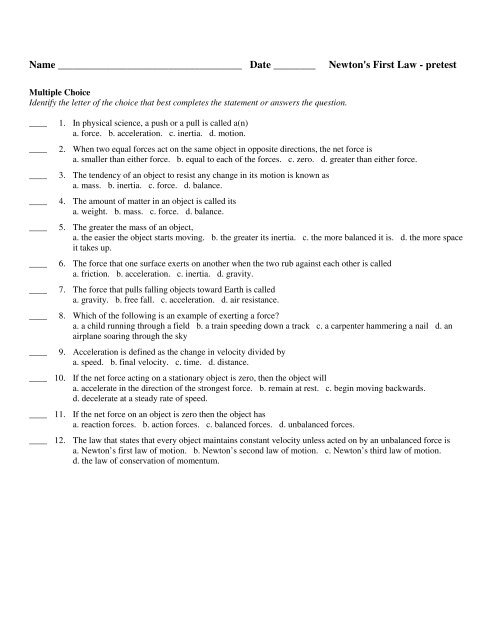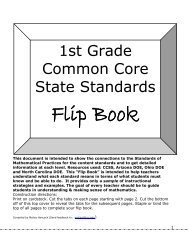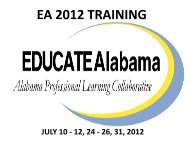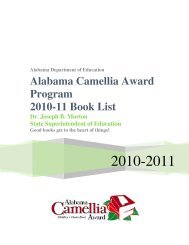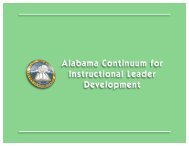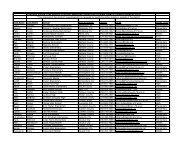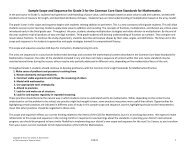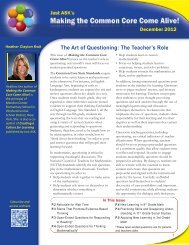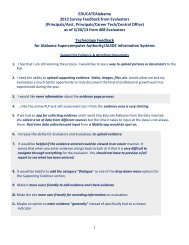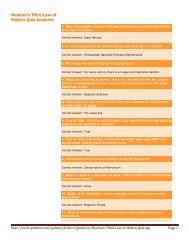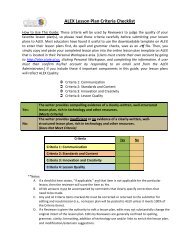Newton's First Law - pretest - Alex
Newton's First Law - pretest - Alex
Newton's First Law - pretest - Alex
You also want an ePaper? Increase the reach of your titles
YUMPU automatically turns print PDFs into web optimized ePapers that Google loves.
Name ___________________________________ Date ________ <strong>Newton's</strong> <strong>First</strong> <strong>Law</strong> - <strong>pretest</strong><br />
Multiple Choice<br />
Identify the letter of the choice that best completes the statement or answers the question.<br />
____ 1. In physical science, a push or a pull is called a(n)<br />
a. force. b. acceleration. c. inertia. d. motion.<br />
____ 2. When two equal forces act on the same object in opposite directions, the net force is<br />
a. smaller than either force. b. equal to each of the forces. c. zero. d. greater than either force.<br />
____ 3. The tendency of an object to resist any change in its motion is known as<br />
a. mass. b. inertia. c. force. d. balance.<br />
____ 4. The amount of matter in an object is called its<br />
a. weight. b. mass. c. force. d. balance.<br />
____ 5. The greater the mass of an object,<br />
a. the easier the object starts moving. b. the greater its inertia. c. the more balanced it is. d. the more space<br />
it takes up.<br />
____ 6. The force that one surface exerts on another when the two rub against each other is called<br />
a. friction. b. acceleration. c. inertia. d. gravity.<br />
____ 7. The force that pulls falling objects toward Earth is called<br />
a. gravity. b. free fall. c. acceleration. d. air resistance.<br />
____ 8. Which of the following is an example of exerting a force?<br />
a. a child running through a field b. a train speeding down a track c. a carpenter hammering a nail d. an<br />
airplane soaring through the sky<br />
____ 9. Acceleration is defined as the change in velocity divided by<br />
a. speed. b. final velocity. c. time. d. distance.<br />
____ 10. If the net force acting on a stationary object is zero, then the object will<br />
a. accelerate in the direction of the strongest force. b. remain at rest. c. begin moving backwards.<br />
d. decelerate at a steady rate of speed.<br />
____ 11. If the net force on an object is zero then the object has<br />
a. reaction forces. b. action forces. c. balanced forces. d. unbalanced forces.<br />
____ 12. The law that states that every object maintains constant velocity unless acted on by an unbalanced force is<br />
a. Newton’s first law of motion. b. Newton’s second law of motion. c. Newton’s third law of motion.<br />
d. the law of conservation of momentum.
<strong>Newton's</strong> <strong>First</strong> <strong>Law</strong> - <strong>pretest</strong><br />
Answer Section<br />
MULTIPLE CHOICE<br />
1. ANS: A<br />
2. ANS: C<br />
3. ANS: B<br />
4. ANS: B<br />
5. ANS: B<br />
6. ANS: A<br />
7. ANS: A<br />
8. ANS: C<br />
9. ANS: C<br />
10. ANS: B<br />
11. ANS: C<br />
12. ANS: A


